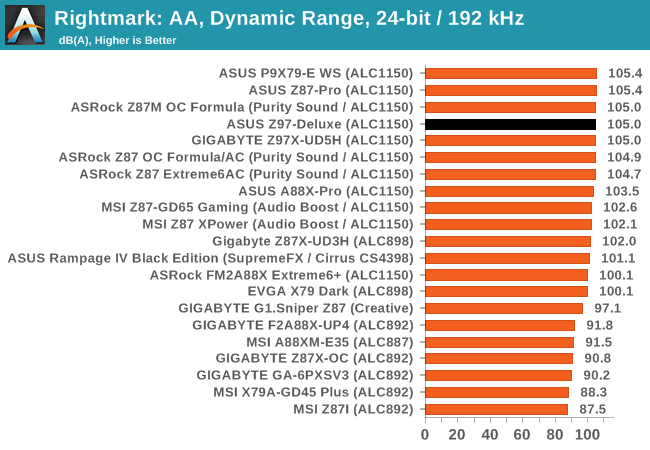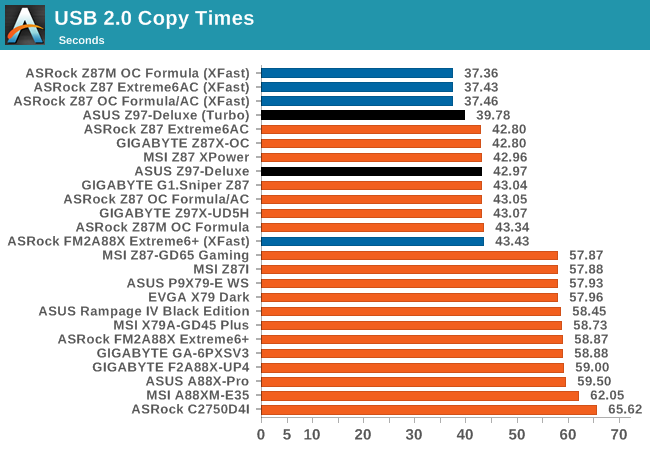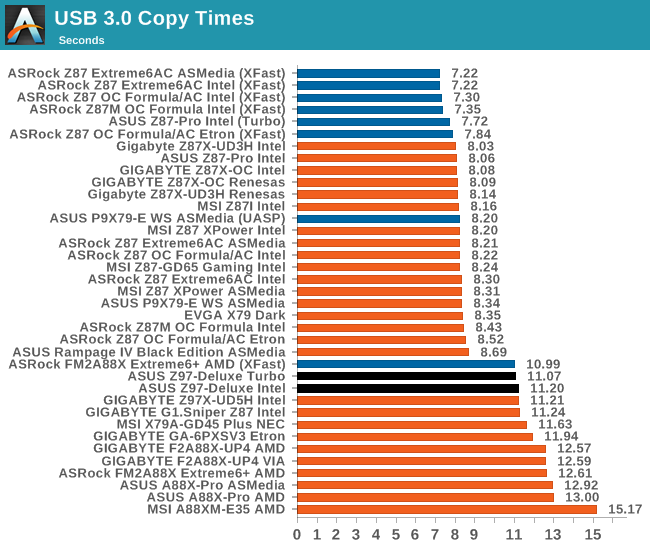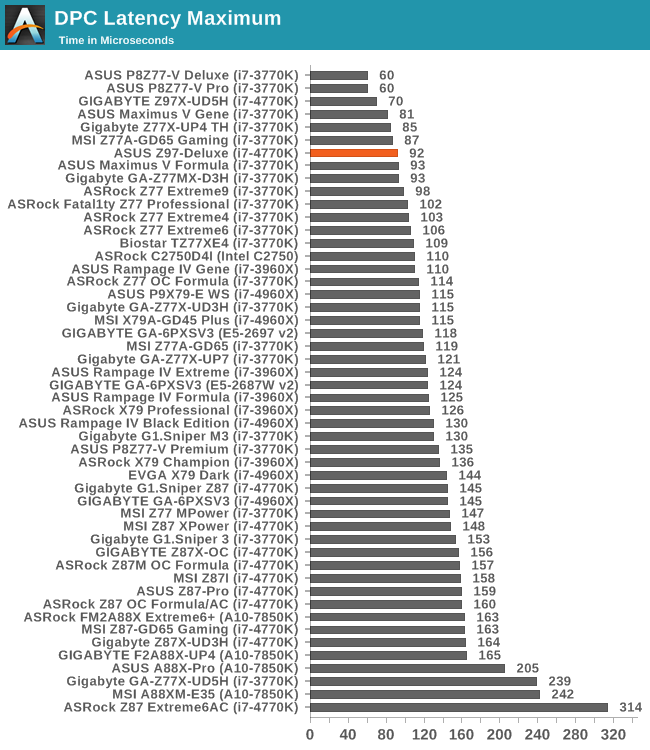ASUS Z97-DELUXE (NFC & WLC) Review: With Two Thunderbolt 2 Too
by Ian Cutress on May 16, 2014 11:00 AM EST- Posted in
- Motherboards
- Intel
- Asus
- NFC
- 802.11ac
- Thunderbolt 2
- Z97
- Wireless Charging
System Benchmarks
Rightmark Audio Analyzer 6.2.5
The premise behind Rightmark:AA is to test the input and output of the audio system to determine noise levels, range, harmonic distortion, stereo crosstalk and so forth. Rightmark:AA should indicate how well the sound system is built and isolated from electrical interference (either internally or externally). For this test we connect the Line Out to the Line In using a short six inch 3.5mm to 3.5mm high-quality jack, turn the OS speaker volume to 100%, and run the Rightmark default test suite at 192 kHz, 24-bit. The OS is tuned to 192 kHz/24-bit input and output, and the Line-In volume is adjusted until we have the best RMAA value in the mini-pretest. We look specifically at the Dynamic Range of the audio codec used on board, as well as the Total Harmonic Distortion + Noise.
Dynamic Range of the Z97-Deluxe


We had one small initial issue with our audio test on the Deluxe, causing distortion at 100% volume when the drivers off the disk were installed. The latest Realtek drivers from the ASUS website worked better, and gave some of the best audio results we have ever seen in our RMAA test.
USB Backup
For this benchmark, we run CrystalDiskMark to determine the ideal sequential read and write speeds for the USB port using our 240 GB OCZ Vertex3 SSD with a SATA 6 Gbps to USB 3.0 converter. Then we transfer a set size of files from the SSD to the USB drive using DiskBench, which monitors the time taken to transfer. The files transferred are a 1.52 GB set of 2867 files across 320 folders – 95% of these files are small typical website files, and the rest (90% of the size) are the videos used in the WinRAR test. In an update to pre-Z87 testing, we also run MaxCPU to load up one of the threads during the test which improves general performance up to 15% by causing all the internal pathways to run at full speed.


USB 2.0 performance with the Turbo mode activated did a good job with around a 10% time saving in the copy test. USB 3.0 gave a smaller increase, and judging by our current USB 3.0 tests on Z97, is a slight regression from Z87.
DPC Latency
Deferred Procedure Call latency is a way in which Windows handles interrupt servicing. In order to wait for a processor to acknowledge the request, the system will queue all interrupt requests by priority. Critical interrupts will be handled as soon as possible, whereas lesser priority requests, such as audio, will be further down the line. So if the audio device requires data, it will have to wait until the request is processed before the buffer is filled. If the device drivers of higher priority components in a system are poorly implemented, this can cause delays in request scheduling and process time, resulting in an empty audio buffer – this leads to characteristic audible pauses, pops and clicks. Having a bigger buffer and correctly implemented system drivers obviously helps in this regard. The DPC latency checker measures how much time is processing DPCs from driver invocation – the lower the value will result in better audio transfer at smaller buffer sizes. Results are measured in microseconds and taken as the peak latency while cycling through a series of short HD videos - less than 500 microseconds usually gets the green light, but the lower the better.

If there was one specific feature to fix from the 8-series motherboards, it was DPC Latency. Every Z87 motherboard we tested scored 150 microseconds or up (except for one at ~140). Like the UD5H, the Z97-Deluxe continues a good trend of below 100 microsecond results for Z97.











45 Comments
View All Comments
Eidigean - Friday, May 16, 2014 - link
First off, This is a great review Ian. The in-depth details of shared PCIe lane distribution between the x4 slot, x2 M.2, and x2 SATAe helped me make a decision...I'm looking for Thunderbolt 2 and two x4 M.2 SSDs. The only board that seems like it will fit the bill is the GIGABYTE GA-Z97X-UD7 TH. Reason being, it's the only board that provides x8/x4/x4 from the CPU while also providing x4 from the Z97 for the Thunderbolt controller. This will allow for a GPU and two Samsung XP941 M.2 SSDs in a RAID 0.
An alternative I'm kicking around is the Asus Z79-WS with its PLX switch; allowing x16 for the GPU, two x4 M.2 SSDs in two x8 slots, and the ASUS Thunderbolt 2 controller in the x4 slot from the Z79.
Ian, could you get your hands on the two Samsung XP941 sticks that Kristian was testing?
Eidigean - Friday, May 16, 2014 - link
The ASUS Z97 lineup would be better if ASUS put a x4 slot in place of the middle or bottom x1 slot and shared 4 lanes from the x8 slot when needed, allowing for x8/x4/x4 in addition to x8/x8. Intel allows for it, and only one vendor (GIGABYTE) is doing it.Eidigean - Friday, May 16, 2014 - link
There's actually another vendor that *almost* meets my requirements, the ASRock Z97 Extreme6. From their user manual:* If M2_1 slot is occupied, PCIE2 slot will run at x8 mode, and PCIE4 slot will run at x4 mode.
That would allow me to run one XP941 stick in the motherboard's M.2 socket, and the other in the PCIE4 slot. The missing feature is Thunderbolt 2; which is only offered by ASUS and GIGABYTE.
Ian Cutress - Friday, May 16, 2014 - link
Hi Eidigean,I have the Z97 Extreme6 in for testing, should have a review (with a single XP941) incoming. I've got some data regarding the impact an x4 M.2 has on GPU performance, stay tuned for that.
-Ian
Taurus229 - Friday, May 16, 2014 - link
Considering this is a $400.00 board, I feel that no one should have to play musical chairs with Sata inputs! Asus missed the boat here!austinsguitar - Friday, May 16, 2014 - link
one does not just simply pay 400+ dollars on just a motherboard with thunderbolt 2's.... this is a little bit overkill and stupid to the common consumer/ marketing executive. This premium doesn't make much since....DMCalloway - Friday, May 16, 2014 - link
Great review! Unfortunately, one of the best selling i7 chips (2600k) isn't in the benchmarks. I do like the progress being made with the UEFI BIOSs. Thanx for the review Ian.EricPraline - Saturday, May 17, 2014 - link
Many high-end motherboards these days use special audio capacitors for 'better' sound in the audio area of the motherboard. The amount of capacitors used in the audio portion of newer motherboards seems to vary using anywhere from 6 to 14 or more depending on the motherboard. Does using more capacitors for audio roughly correlate with a better sound? Why is there a difference in the number of audio capacitors used among high-end ALC1150-based motherboards, even by the same manufacturer (e.g., Asus)Haravikk - Saturday, May 17, 2014 - link
I find the selection of SATA ports and the juggling act of connecting them a bit weird; I thought that one of the advantages of SATA Express was that you could still use it as two ordinary SATA ports, only getting the increased speed when you connected a full SATA Express cable? With that in mind I don't see why this really needs so many additional, regular SATA ports anyway; an extra two would be enough for most people, as that gives you either six regular SATA drives, or two SATA Express and two regular SATA. Or they could even have gone for four SATA Express which would be even better as it gives you four to eight ports.I dunno, it just feels a bit like an odd in-between standards kind of mixture; since Intel will most likely be pushing to increase PCI lanes on future processors then it just seems like if you need so much connectivity you're still better going for a dual processor motherboard, or waiting a year for more Thunderbolt friendly processors.
Laststop311 - Monday, May 19, 2014 - link
Seems to me Intel needs to stop cheaping out on the pci-e lanes for its mainstream line. Now that sata express needs 4x pci-e 3.0 lanes to function to it's maximum. Asrock Extreme 9 is the only board right now that allows you to connected an SSD directly to the CPU using 4 pci-e 3,0 lanes and surprise those drives function the best. With skylake and Z107 intel really needs to step up its pci-e lane game.